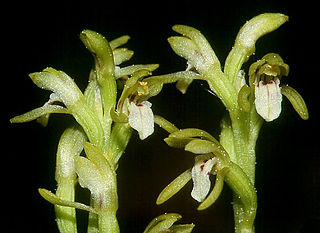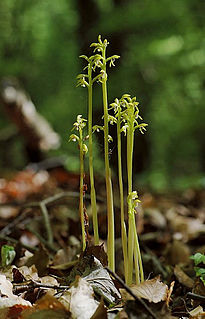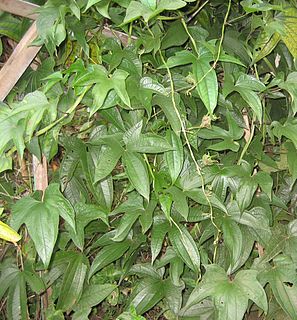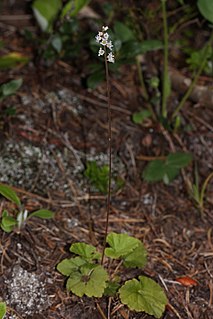
The Malvales are an order of flowering plants. As circumscribed by APG II-system, the order includes about 6000 species within 9 families. The order is placed in the eurosids II, which are part of the eudicots.

Malvaceae, or the mallows, is a family of flowering plants estimated to contain 244 genera with 4225 known species. Well-known members of economic importance include okra, cotton, cacao and durian. There are also some genera containing familiar ornamentals, such as Alcea (hollyhock), Malva (mallow) and Lavatera, as well as Tilia. The largest genera in terms of number of species include Hibiscus, Sterculia, Dombeya, Pavonia and Sida.

Bombacaceae were long recognised as a family of flowering plants or Angiospermae. The family name was based on the type genus Bombax. As is true for many botanical names, circumscription and status of the taxon has varied with taxonomic point of view, and currently the preference is to transfer most of the erstwhile family Bombacaceae to the subfamily Bombacoideae within the family Malvaceae in the order Malvales. The rest of the family were transferred to other taxa, notably the new family Durionaceae. Irrespective of current taxonomic status, many of the species originally included in the Bombacaceae are of considerable ecological, historical, horticultural, and economic importance, such as balsa, kapok, baobab and durian.

Sterculiaceae was a family of flowering plants based on the Genus Sterculia. Genera are now placed in the Family Malvaceae, in the subfamilies: Byttnerioideae, Dombeyoideae, Helicteroideae and Sterculioideae.

Corallorhiza, the coralroot, is a genus of flowering plants in the orchid family. Except for the circumboreal C. trifida, the genus is restricted to North America.

Malvoideae is a botanical name at the rank of subfamily, which includes in the minimum the genus Malva. It was first used by Burnett in 1835, but was not much used until recently, where, within the framework of the APG System, which unites the families Malvaceae, Bombacaceae, Sterculiaceae and Tiliaceae of the Cronquist system, the aggregate family Malvaceae is divided into 9 subfamilies, including Malvoideae. The Malvoideae of Kubitzki and Bayer includes 4 tribes:-

Corallorhiza trifida, commonly known as early coralroot, northern coralroot, or yellow coralroot, is a coralroot orchid native to North America and Eurasia, with a circumboreal distribution. The species has been reported from the United States, Canada, Russia, China, Japan, Korea, India, Nepal, Kashmir, Greenland, Pakistan, and almost every country in Europe.
Annual mallow is a common name for several plants and may refer to:

Ambrosia trifida, the giant ragweed, is a species of flowering plant in the sunflower family. It is native to North America, where it is widespread in Canada, the United States, and northern Mexico.

Malope trifida is a species of Malope native to the Western Mediterranean Region. This plant is often used as an ornamental plant.
Sensu is a Latin word meaning "in the sense of". It is used in a number of fields including biology, geology, linguistics, semiotics, and law. Commonly it refers to how strictly or loosely an expression is used in describing any particular concept, but it also appears in expressions that indicate the convention or context of the usage.

Dioscorea trifida is a species of flowering plant in the family Dioscoreaceae. It is a species of yam. It is native to the Caribbean and Central and South America. Its many common names include Indian yam, cush-cush, and yampee. It is called mapuey in Venezuela, inhame in Brazil, tabena and ñame in Colombia, sacha papa in Peru, and ñampi in Costa Rica.
Gahnia trifida, the coastal saw-sedge, is a tussock-forming perennial in the family Cyperaceae, endemic to southern Australia.

Bouteloua trifida is a species of grass known by the common name red grama. It is native to central and northern Mexico and the Southwestern United States, where it grows in desert scrub and other dry areas.

Batsogile Lovederia Malope known professionally as DrRebecca Malope, is a multi-award-winning South African gospel singer. She is known as "The African Queen of Gospel." Her music career spans more than three decades. She has sold at least 10 million albums worldwide, making her one of the biggest selling gospel artists of all time. Most of the 36 albums she has released have reached multi-platinum status.

Mitella trifida is a species of flowering plant in the saxifrage family known by the common names threeparted miterwort and Pacific miterwort. It is native to western North America from Alaska to Montana to California, where it grows in wet wooded habitat types. It is a rhizomatous perennial herb growing up to about 45 centimeters tall. The leaves occur around the base of the stem. They have rounded blades up to 10 centimeters wide and lobed, round-toothed edges. The erect inflorescence bears up to 20 flowers, usually along one side of the stem. The distinctive flower is cup-shaped with five white or violet-tinged petals which are usually, but not always, divided into three lance-shaped lobes.

Malveae is a tribe of flowering plants in the mallow family Malvaceae, subfamily Malvoideae. The tribe circumscribes approximately 70 genera and 1040 species and has the greatest species diversity out the three tribes that make up Malvoideae. The flowers of Malveae are five-merous with a characteristic staminal column, a trait found throughout Malvoideae. Although there are not many economically important species within Malveae, the tribe includes Althaea officinalis, otherwise known as the Marsh Mallow.

Odostomia trifida, common name the three-toothed odostome, is a species of sea snail, a marine gastropod mollusk in the family Pyramidellidae, the pyrams and their allies.
Grevillea trifida is a shrub of the genus Grevillea native to an area in the South West and Great Southern regions of Western Australia.

Lake Hawdon South Conservation Park is a protected area located in the Australian state of South Australia in the locality of Bray about 280 kilometres (170 mi) south-east of the state capital of Adelaide and about 18 kilometres (11 mi) east of the town of Robe.
















